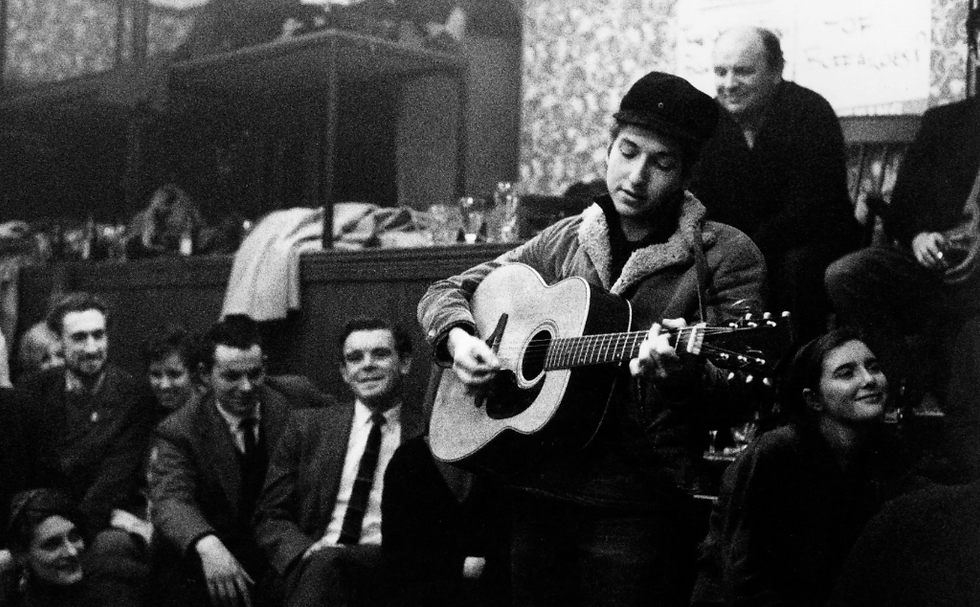Why Every Artist Owes a Debt to Bob Dylan- From Protest to Pop: Dylan’s Enduring Musical Influence
- The Gooch

- Jan 8
- 6 min read
The Story of Bob Dylan: A Musical Revolution
Born Robert Allen Zimmerman on May 24, 1941, in Duluth, Minnesota, Bob Dylan grew up steeped in the traditions of American folk music. Inspired by Woody Guthrie, blues, and early rock 'n' roll, Dylan's early years were a quest to find his voice in the rapidly changing cultural landscape of the 1960s.

The Folk Prophet (1961–1964)
Dylan burst onto the New York City folk scene in the early ’60s, quickly becoming a voice for a generation. His self-titled debut album in 1962 was a modest beginning, but his next works, The Freewheelin’ Bob Dylan (1963) and The Times They Are a-Changin’ (1964), positioned him as a protest poet. Songs like "Blowin’ in the Wind" and "A Hard Rain’s a-Gonna Fall" became anthems of the Civil Rights Movement and anti-war activism.

Going Electric (1965–1966)
Dylan shocked the folk world in 1965 by “going electric” at the Newport Folk Festival. With albums like Bringing It All Back Home and Highway 61 Revisited, he fused poetic lyricism with rock instrumentation, paving the way for modern rock music. The monumental "Like a Rolling Stone" redefined what a pop song could be, both in structure and storytelling.


The Poet of Transformation (1967–1975)
After a near-fatal motorcycle accident in 1966, Dylan retreated from public life and returned with John Wesley Harding (1967), a subdued, country-inspired record. The Nashville Skyline (1969) album showcased Dylan’s versatility, embracing a warm, crooning style. He continued to evolve, releasing Blood on the Tracks (1975), often hailed as one of the greatest breakup albums of all time.


Reinvention and Influence (1980s–Present)
Dylan’s journey through the ’80s and ’90s reflected both challenges and triumphs. His 1997 album Time Out of Mind marked a late-career renaissance, earning him critical acclaim and new audiences. In 2016, Dylan made history by becoming the first songwriter to win the Nobel Prize in Literature, honored for “having created new poetic expressions within the great American song tradition.”


Legacy and Impact
Bob Dylan’s influence spans genres, inspiring artists from The Beatles to Jimi Hendrix, Bruce Springsteen to Adele. Known for his enigmatic persona and constant reinvention, Dylan blurred the boundaries between poetry and music, folk and rock, tradition and innovation.

Why Do So Many Artists Cover Bob Dylan's Songs?
Timeless Lyrics:Dylan's lyrics are universal, poetic, and often open to interpretation. They resonate with people across cultures and generations.


Versatility:His songs can be adapted to various genres, including folk, rock, pop, country, blues, and even jazz.
Emotional Depth:Dylan's ability to capture profound emotions in simple, evocative words makes his music deeply relatable.
Cultural Influence:Covering Dylan is often seen as a way to pay homage to one of the most influential songwriters in history.
Musical Simplicity:Many Dylan songs are built around simple chords and melodies, making them accessible for reinterpretation.

Artists Who Have Covered Bob Dylan
Here’s a list of prominent artists (and their notable Dylan covers):
Folk and Rock Artists:
Joan Baez – "Blowin’ in the Wind," "Love Is Just a Four-Letter Word"
The Byrds – "Mr. Tambourine Man," "My Back Pages"
Jimi Hendrix – "All Along the Watchtower" (arguably the most famous Dylan cover)
The Band – "I Shall Be Released," "When I Paint My Masterpiece"


Pop and Country Icons:
Adele – "Make You Feel My Love"

Johnny Cash – "It Ain’t Me Babe," "Don’t Think Twice, It’s All Right"
Garth Brooks – "To Make You Feel My Love"
Willie Nelson – "What Was It You Wanted"
Blues and Jazz Musicians:

Nina Simone – "Just Like a Woman," "The Times They Are a-Changin’"
Etta James – "I’ll Be Your Baby Tonight"

Alternative and Indie Bands:
Pearl Jam – "Masters of War"
The White Stripes – "One More Cup of Coffee"
Wilco – "Simple Twist of Fate"
Modern Interpretations:
Miley Cyrus – "Baby, I’m in the Mood for You"
Ed Sheeran – "Masters of War" (acoustic version)
Kesha – "Don’t Think Twice, It’s All Right"


The Grateful Dead's
deep connection to Bob Dylan's music stems from their shared ethos, overlapping themes, and mutual admiration. Here's why the Dead covered so many Dylan songs and how it enriched both their legacy and Dylan’s:
Shared Philosophical Ground
Both Bob Dylan and the Grateful Dead embraced countercultural ideals. They explored themes like personal freedom, introspection, and societal change, making Dylan’s lyrics resonate deeply with the Dead’s approach to music and storytelling.
Dylan's poetic and often abstract lyrics matched the Dead's own penchant for mysticism and improvisation.

Love of American Roots Music
Dylan and the Dead shared a deep appreciation for American roots music, including folk, blues, and country. Covering Dylan allowed the Grateful Dead to explore those traditions while infusing them with their unique jam-band style.
Dylan as a Songwriter's Songwriter
Bob Dylan's songs are known for their lyrical depth and narrative richness. The Grateful Dead recognized Dylan's ability to craft timeless stories, making his songs ideal material for reinterpretation in live performances.

The Jam-Band Factor
The Grateful Dead’s improvisational style thrived on flexible song structures, and Dylan's compositions lent themselves perfectly to this approach. Songs like "Knockin’ on Heaven’s Door" and "All Along the Watchtower" provided expansive frameworks for the Dead to explore musically.

Mutual Admiration and Collaboration
The relationship between Dylan and the Grateful Dead wasn’t just one-sided admiration—it was mutual. In 1987, they even toured together as Dylan & the Dead, showcasing their collaborative chemistry.
Jerry Garcia, the Dead's frontman, was an avid Dylan fan and often spoke of how Dylan's music shaped his artistic sensibilities.
Connection to the Dead’s Audience
Dylan's songs often carried themes of spirituality, rebellion, and transcendence, which aligned perfectly with the values of the Grateful Dead's fanbase, the Deadheads. Covering Dylan allowed the band to deepen their connection with their audience.

Extensive Repertoire
The Grateful Dead were known for their massive repertoire, constantly changing their setlists. Dylan’s vast catalog gave them plenty of material to draw from, keeping their live performances fresh and unpredictable.
Notable Dylan Covers by the Grateful Dead
The Grateful Dead covered more than 30 Dylan songs throughout their career. Some of the most notable include:
"It’s All Over Now, Baby Blue" – A staple in their live shows from the mid-’60s onward.
"All Along the Watchtower" – Often transformed into a high-energy jam.
"Knockin’ on Heaven’s Door" – A soulful, introspective crowd favorite.
"Desolation Row" – Showcased the Dead’s ability to handle Dylan’s complex lyrics.
"When I Paint My Masterpiece" – A joyful, reflective rendition.
"She Belongs to Me" – Performed with a haunting, dreamlike quality.




Legacy of the Dylan-Dead Connection
The Grateful Dead’s reinterpretations of Dylan’s music introduced his songs to a new audience and gave them a fresh perspective. At the same time, Dylan’s collaborations with the Dead, especially during the Dylan & the Dead tour, allowed him to experiment with a looser, jam-oriented performance style.
A Shared Legacy
Both Bob Dylan and the Grateful Dead are iconic figures in American music, united by their ability to transcend genres, connect with audiences, and create timeless art. The Dead’s covers of Dylan songs are a testament to the power of reinterpretation and the universality of Dylan’s songwriting.


Why These Covers Stand Out
Reinterpretation:Many artists add their own flair, like Jimi Hendrix’s electric, soulful reimagining of "All Along the Watchtower" or The Byrds’ jangly, folk-rock take on "Mr. Tambourine Man."
Resonance:The emotional and social themes of Dylan’s music remain relevant, which is why artists from every era feel compelled to reinterpret his songs.
Cross-Generational Appeal:Covering Dylan bridges gaps between old and new listeners, introducing his genius to fresh audiences.
Today, Dylan remains a cultural icon, a living embodiment of artistic authenticity, and a testament to the power of words to shape the world.
A Complete Unknown" is the latest biopic
exploring the life of Bob Dylan, focusing on his transformative years in the early 1960s. Directed by James Mangold, known for "Walk the Line," the film stars Timothée Chalamet as Dylan, capturing his journey from a Minnesota musician to a pivotal figure in the New York folk scene.
Plot and Focus
The narrative centers on Dylan's arrival in New York City in 1961 and culminates with his controversial electric performance at the Newport Folk Festival in 1965. This period marks Dylan's evolution from acoustic folk to electric rock, a shift that redefined his career and influenced the music landscape.
Cast
Timothée Chalamet as Bob Dylan
Monica Barbaro as Joan Baez, Dylan's collaborator and romantic partner
Elle Fanning as Sylvie Russo, a character inspired by Suze Rotolo, Dylan's early muse
Ed Norton as Pete Seeger, a prominent folk musician
Boyd Holbrook as Johnny Cash
Norbert Leo Butz as Albert Grossman, Dylan's manager


Production Details
The film's development began in January 2020, with Chalamet undergoing extensive preparation, including learning guitar and harmonica, and studying Dylan's mannerisms. Filming commenced in 2024, with a focus on authenticity in depicting the 1960s music scene.
Release Information
"A Complete Unknown" premiered in the U.S. on December 25, 2024, and is scheduled for release in the U.K. on January 17, 2025.

Critical Reception
The film has garnered praise for Chalamet's portrayal of Dylan, particularly his musical performances. However, discussions have emerged regarding the film's historical accuracy, with some events and timelines altered for dramatic effect. Notably, the character Sylvie Russo is a fictionalized representation of Suze Rotolo, reflecting the film's blend of fact and creative interpretation.







Comentários